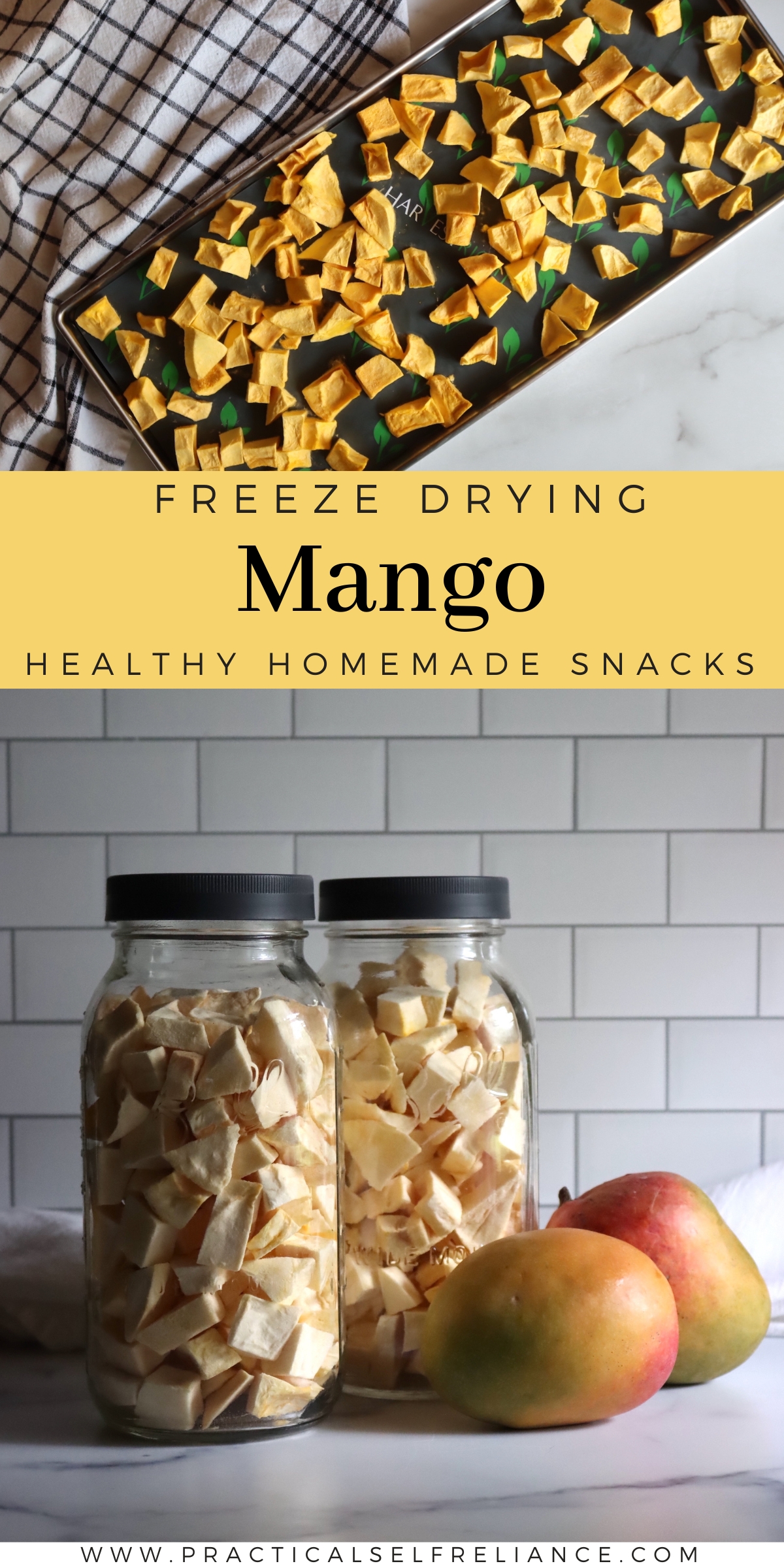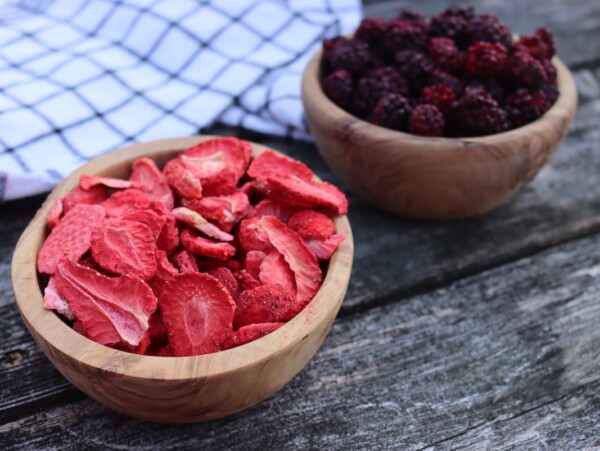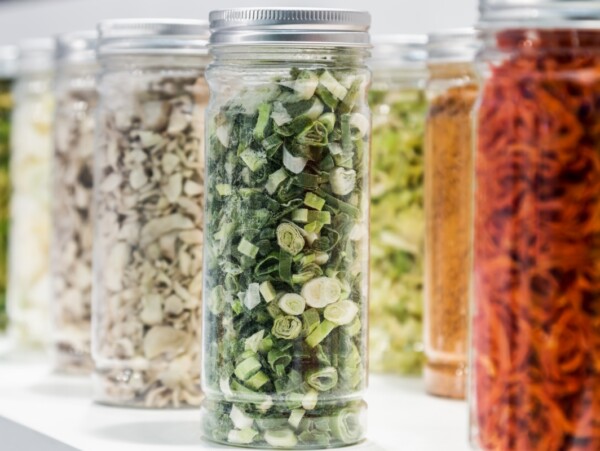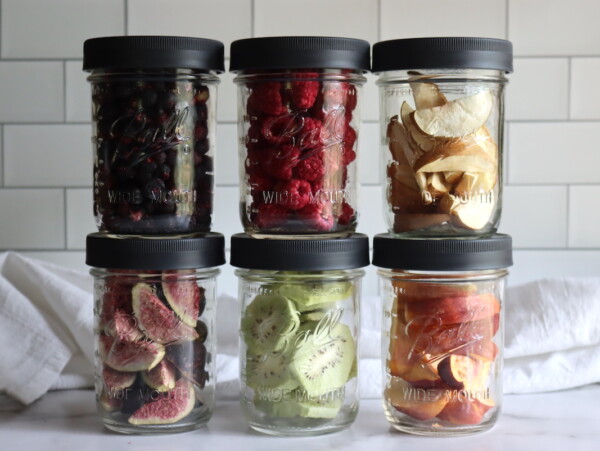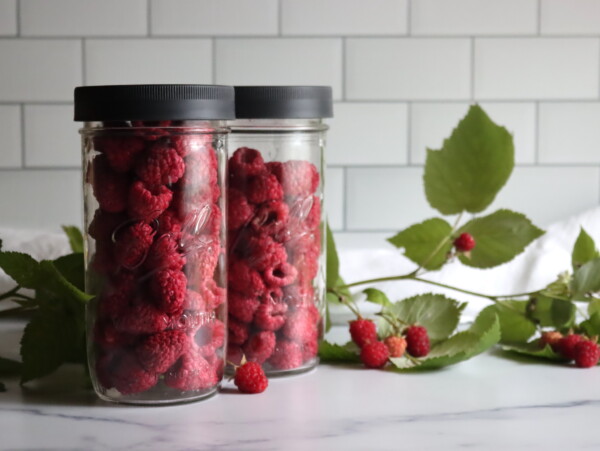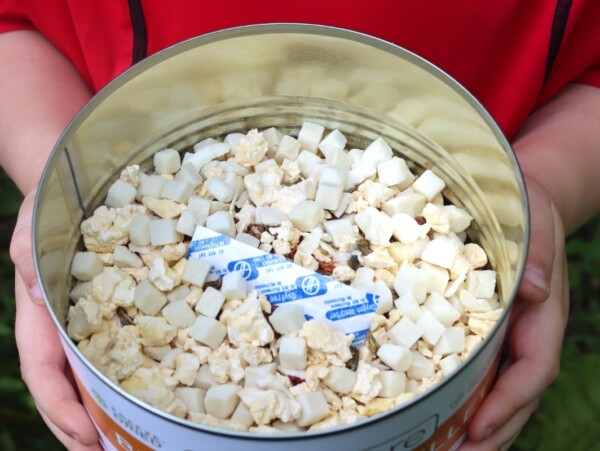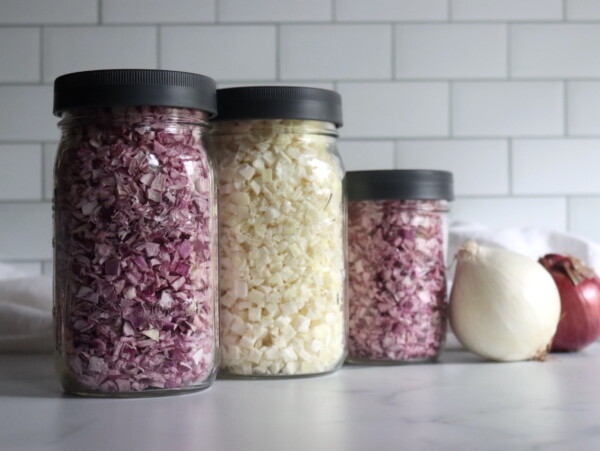Affiliate disclosure: This post may contain affiliate links. Please see our Privacy Policy.
Freeze-dried mangoes are a sweet and tangy treat, and they’re easy to make at home with a home freeze dryer. While store-bought versions can be pricey, freeze-drying mangoes at home yields a simple, cost-effective snack.
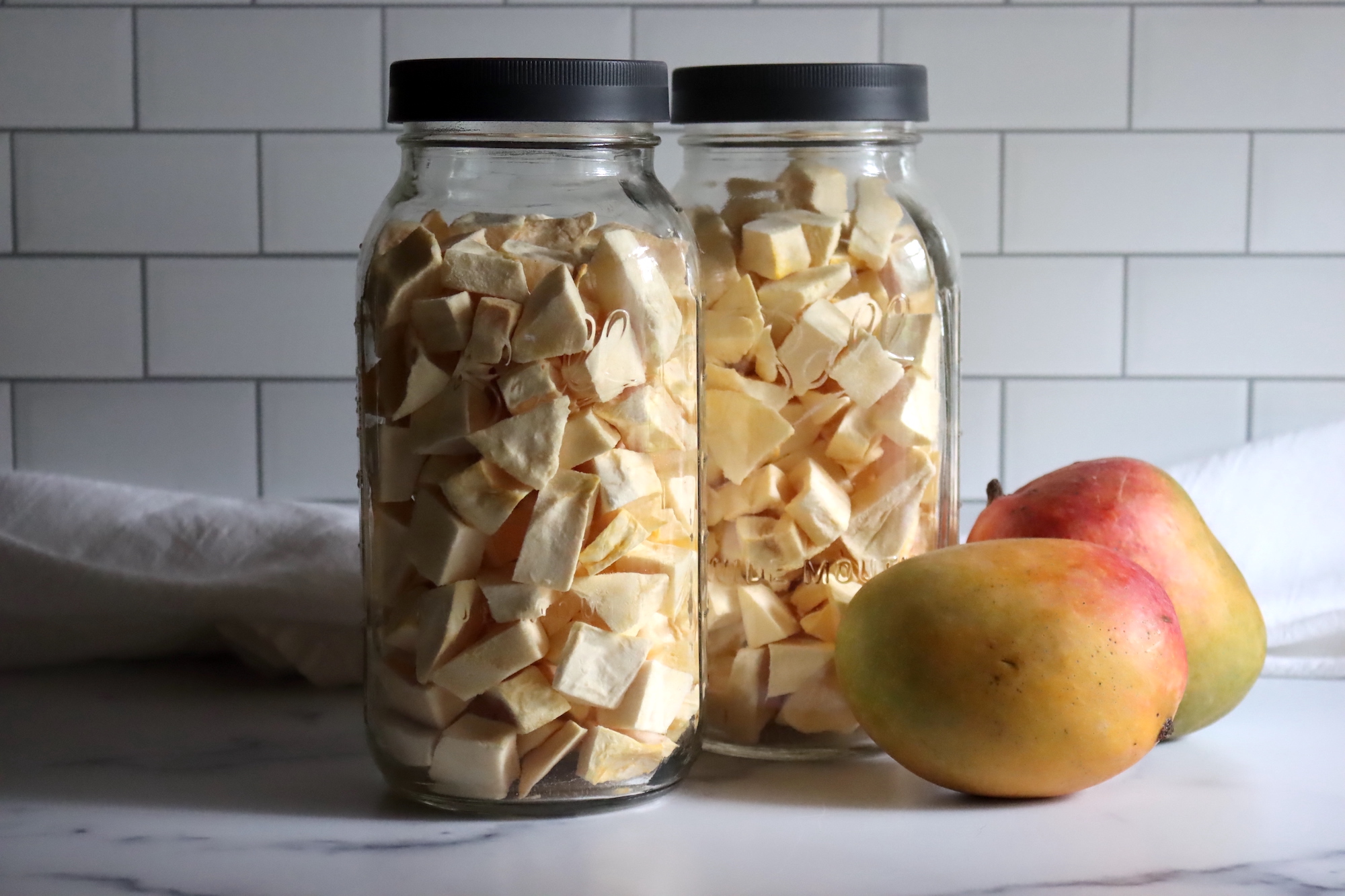
Table of Contents
Freeze-dried mangoes are delicious snacks to keep on the pantry shelf. Kids love these crunchy treats as much as candy, and for adults, they make a great alternative to snacking on potato chips. They’re second only to freeze dried strawberries in this house, both of which are unbelievably good (and good for you).
They’re so sweet, they’re almost like freeze dried candy, but healthy.
Freeze-drying preserves these nutrients and concentrates the tropical flavors of mango into a wonderful, crunchy bite to enjoy any time of the year.
Sure, I love homemade mango jam, but it’s got quite a bit of added sugar. This gives you all that mango flavor, and nothing else.
If you’re not familiar with freeze drying, start with my beginner’s guide to freeze drying at home so you can understand how a home freeze dryers works.
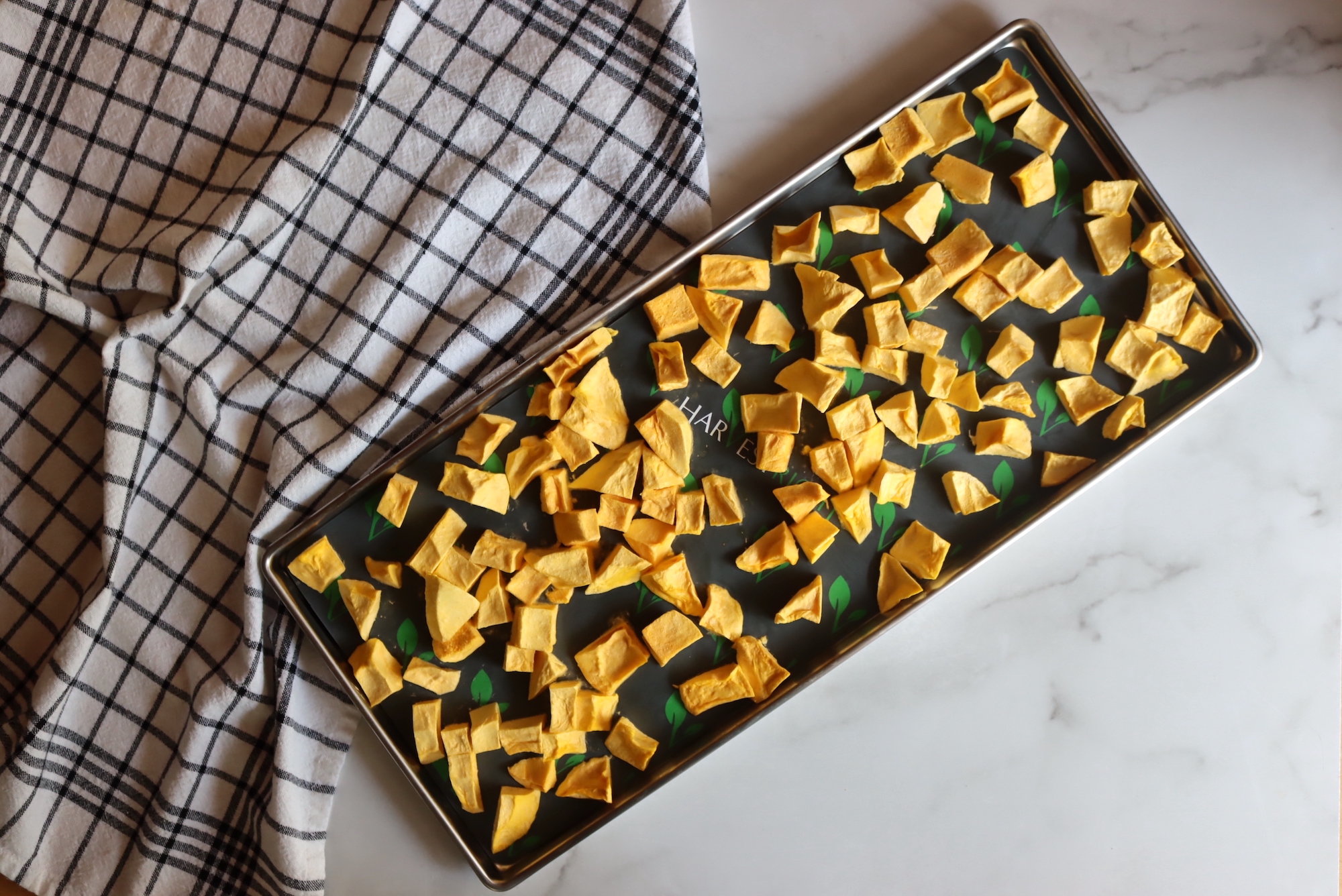
What’s the Difference Between Freeze Dried Mango and Dehydrated Mango?
Freeze-dried mangoes have several key differences from dehydrated mangoes.
Freeze-dried foods are superior in flavor, texture and shelf-life. Research even shows freeze-drying may preserve more nutritional content than any other preservation method — retaining about 90% of the nutritional content, while dehydration preserves around 60% to 70%.
Because dehydration solely uses heat to preserve foods, it can sometimes give fruits a bit of a cooked flavor. The end result often possesses a chewier texture as well.
By contrast, freeze-drying uses a rapid freezing technique along with vacuum drying to preserve foods. The end product is more flavorful, with a crunchier texture that can be rehydrated to nearly the same form as fresh. Very little shirking occurs and foods often rehydrate to the same size as before they were preserved.
Shelf life is another aspect in which freeze-drying outperforms. Freeze-dried foods can last for decades under proper storage, unlike many dehydrated foods.
There’s nothing at all wrong with dehydrating as a preservation method. For certain foods like apples and pineapple, it’s quite nice. Freeze-drying just seems to work better for certain fruits, mango being one of them.
Best Mango to Freeze Dry
The best mangoes to freeze-dry are fresh and ripe. Freeze-drying won’t do anything to improve the quality of food so you want to use the best produce you can find. If you freeze-dry underripe or overripe fruit, it will still taste underripe or overripe once freeze-dried. The only difference is that these flavors will be more concentrated due to the removal of water.
There are actually several varieties of mangoes to choose from. Ataulfos or champagne mangoes are sweet and creamy with a high flesh-to-seed ratio. Usually imported from Mexico, you’ll usually find them from March through July.
The Francis mango is smaller and hails from Haiti. The Haden mango is firm and floral-tasting. There are also Keitt and Kent varieties. However, the most popular mango you’ll find in the U.S. is Tommy Atkins. Its flavors are sweet, tart and mild with a fibrous flesh. You’ll often find it from March to July and October to January.
There are also more exotic mango varieties like the Alphonse or Kesar which come from India or Philippine mangos, like the Manila or Carabao mango.
The variety isn’t terribly important, as long as you choose to process your mangoes at their peak stage of ripeness. A ripe mango should be fragrant near the stem and have a slight give when squeezed as a peach would.
If your mangoes aren’t ripe yet, leave them at room temperature until they ripen. This will ensure your freeze-dried mango will taste as exceptional as possible.
Freeze Dried Mango Yield
Wondering how many mangoes you’ll be able to fit in a batch? That will depend on a few things: the size and variety of the mangoes you use as well as the capacity of your freeze-dryer.
On average, a ripe 12 oz mango should yield about 1 cup of fruit once the flesh is removed from the peel and pit. A larger mango will yield a bit more.
Smaller mangoes like the Ataulfo mango might yield 1 cup, but larger mangoes like the Haden or Kent variety can end up being 2 cups or more.
So honestly, it depends on the size of your mango variety. Either way, a cup of fresh mango should provide you with a cup of freeze-dried mango, since the size won’t change at all.
How many mangoes you can fit in a batch depends on the size and number of your trays, and how tightly you decide to pack them. My freeze dryer is an older large model — it is rated for 15 to 20 lbs of food over its 5 drying trays.
If I really pack everything in, I can fit 3 to 4 pounds of fresh fruit per tray, however, I prefer to stick to 2 to 3 pounds instead for a shorter drying time. Each freeze drying machine will be rated for a certain amount of food, so how much you can fit in your freeze dryer depends on its size.
These are the average load amounts based on appliance size:
- Small Freeze Dryer: Processes 6 to 10 pounds of food per batch, across 4 trays (434 square inches of drying space).
- Medium Freeze Dryer: Processes 10 to 15 pounds of food per batch, across 5 trays (675 square inches of drying space).
- Large Freeze Dryer: Processes 18 to 27 pounds of food per batch, across 6 trays (1107 square inches of drying space).
- Extra Large Freeze Dryer: Processes 40 to 50 pounds of food per batch, across 7 trays (2257 square inches of drying space).
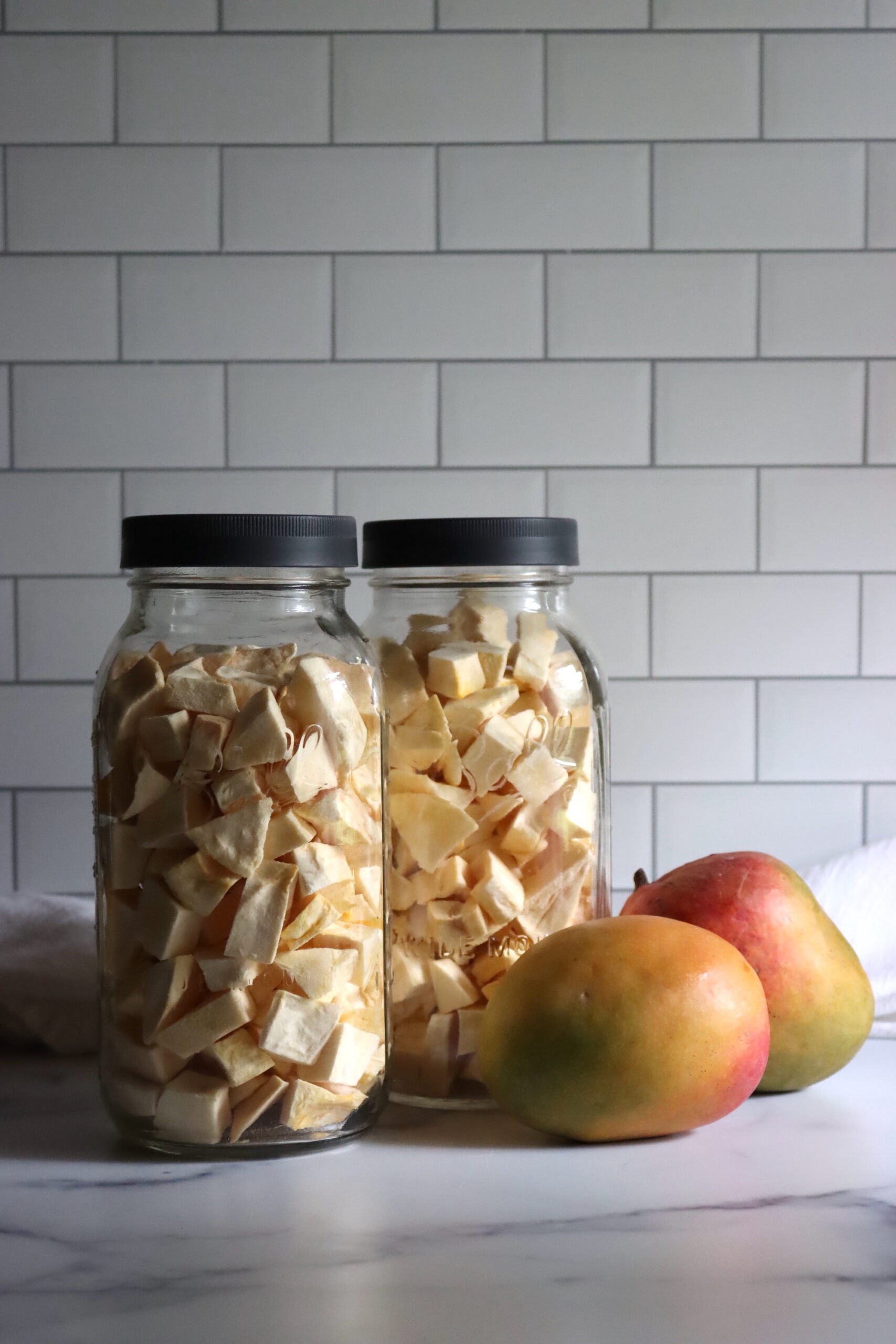
Supplies Needed
To freeze-dry mangoes at home, you’ll first need a few items. These will include:
- Mangoes – Peeled, pitted and processed. Either fresh or frozen will work.
- Home Freeze Dryer – Bigger freeze dryers are more economical than smaller ones that are run more frequently, so opt for the largest size that makes sense for your situation.
- Cutting Board and Knife – For slicing your mangoes into even-sized sections. Mango can be cubed, sliced into wedges or even diced.
- Silicone Tray Liners (or Parchment Paper) – Sticky sweet mangoes will stick to trays, especially if they are juicy. Save yourself from prying fruits off trays by lining them with parchment paper or silicone liners beforehand.
- Colander and Towels – You should always wash fruit before cutting so you don’t transfer bacteria from the outside to the inside. Still, you don’t want excess water extending your freeze-dry time, so be sure to pat fruits dry.
- Mason Jars (or Airtight Storage Containers) – Tasty freeze-dried mango doesn’t frequently last long in our house, so we usually just store it in mason jars on the pantry shelf. For long-term, storage you’ll require Mylar bags with oxygen absorbers.
- Vacuum Sealer (Optional) – A vacuum sealer is great if you plan on starring foods in mason jars — it helps seal them with minimal air inside, consequently lengthening shelf life,
- Label Tape and a Pen – Never forget to label! Labeling the contents and particularly the date is an essential step in food preservation no matter if your foods are in clear jars or nontransparent mylar bags.
Preparing Mango for Freeze Drying
To prepare mangoes for freeze-drying, you will first need to cut, pit and peel them.
There are several techniques for cutting a mango. A good method is to sit the mango on one end and slice either side lengthwise away from the pit. You can then make crosswise cuts in the side pieces, inverting the peel and slicing off little mango sections. The middle section can also be cut in slices to remove the remaining flesh from the flat, oblong pit.
You can also simply use a vegetable peeler to remove the mango peel and then slice the sections into wedges. You can cut mangoes into whatever form you like: wedges, chunks or cubes. I recommend trying to keep slices around ¼ to ½ inch thick.
Some fruits, like freeze dried melon, are great as big chunks that you can bite into, but mango is better in bite sized bits.
Once you’ve peeled and pitted your mangoes, you can also pop slices into a food processor like I do with my Breville Slice and Dice food processor occasionally to dice up fruit. It’s a handy tool for a variety of food preservation tasks, whipping fruits and veggies into ⅓ inch, ½ inch or ⅔ inch cubes in seconds.
After slicing or dicing, you can move straight on to freeze-drying, or pre-freeze fruit the day before to shorten the time needed in the freeze dryer. I recommend freezing mango directly on the freeze-drying trays if at all possible rather than in freezer bags. The fruit tends to freeze together into a giant hunking mess in freezer bags, so I suggest using shallow baking pans or freeze-drying trays only for pre-freezing.
How to Freeze Dry Mango
Once you’ve sliced your mango, the process of freeze-drying mango is quite simple.
Switch on your freeze dryer and let it pre-chill for 30 minutes.
Next, turn your attention to your trays. I always recommend lining trays with silicone liners or parchment paper first so you won’t need to pry the food off later. This has a double benefit in my opinion: a prettier looking end product and a shorter cleanup.
Follow this by arranging your mango slices on the trays in a single layer. A little overlap is fine, but too much will just extend your freeze-drying time.
Once your machine is pre-chilled and your trays are full, you can insert the trays and shut the door. Now, all you have to do is press “continue” and your freeze dryer will take it from here.
When securely packed, freeze-dried fruits like mango can last upwards of 30 years. For this sort of longevity, you will need to seal foods in mylar pouches with oxygen absorbers.
When kept on the pantry shelf in a mason jar or another airtight container, freeze-dried mango will keep for 1 or 2 years while sealed. Jars or containers that are frequently opened may spoil sooner as each time a vessel is opened, moisture is reintroduced to the food through ambient humidity in the air.
The particular flavors of your freeze-dried mango will depend on the specific variety of fruit you chose and its ripeness. If you select mangoes that are sweet and fragrant, they should have these same qualities coming out of the freeze dryer.
Some prefer their mangoes to have a little more tartness and prefer to freeze-dry them before they reach the ultra-ripe stage of peak sweetness. The choice is yours. Just remember: freeze-drying does nothing to improve or alter the flavors of your food — it just suspends them at the exact stage they were when they went in.
Flavors may then seem concentrated in your final freeze-dried product as the fruit is no longer diluted by water. Always choose the best quality fruit to freeze-dry and process it at your preferred stage of ripeness for the best outcome.
Mango can take slightly longer than other fruits to freeze-dry, especially if the fruit is particularly juicy. On average, it usually takes somewhere between 30 and 40 hours to freeze-dry mangoes, but the actual time can vary.
The largest factors which affect freeze-drying time are:
Pre-Freezing: If your mangoes are pre-frozen before entering the freeze dryer, this will reduce the initial freezing time.
Piece Size: Bigger chunks of fruit often take longer than smaller sections.
Moisture in the Fruit: High-moisture fruits like mango will take longer to freeze-dry. Certain varieties of mango with more moisture will have longer dry times as well.
Fully freeze-dried mangoes should be firm and lightweight. Pieces should snap easily in half.
To ensure your batch is done, take a large piece and break it in two. There should be no moisture inside.
If any pieces are not entirely dry throughout, you should slide the batch back in and extend the drying time by a few more hours.
Reconstituting Freeze Dried Mango
People tend to simply eat freeze-dried mango as is, in all its crunchy, sweet glory. Still, it can be rehydrated if needed for recipes where fresh is commonly used.
To rehydrate freeze-dried mango, place the fruit in a bowl and cover it with warm water. Let the mango reconstitute for 20 to 30 minutes, drain off the additional water and use as you would fresh mango.
How to Store Freeze Dried Mango
For snacking or short-term storage, you can store freeze-dried mango casually in an airtight container with a tight-fitting lid. Mason jars are a great option for pantry storage like this.
For extended storage, a different method will be needed. When it comes to long-term storage, freeze-dried foods will need to be sealed in mylar bags with oxygen absorbers.
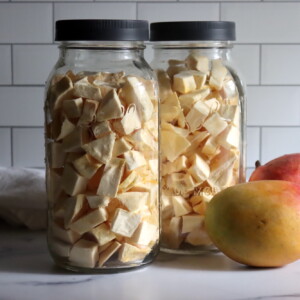
Freeze Drying Mango
Ingredients
- Mangoes, Fresh or Frozen
Instructions
- Begin by pre-chilling your freeze dryer for 30 minutes.
- Wash, dry and process mangoes next. You will want to remove the peel and slice the flesh from the pit. Mangoes can be cut into whatever form you like: wedges, chunks or diced.
- Line drying trays with parchment paper or silicone liners (these will help with sticking and cleanup). Arrange the fruit on top in a single layer.
- When the freeze dryer is pre-chilled, slide the trays into your freeze dryer and close the door. Press “continue.” The freeze dryer should now run for a full cycle. This will take at least 24 hours to complete, usually taking closer to 30 to 34 hours. Time can vary based on moisture content, how heavily trays are packed and piece size.
- When the freeze-drying cycle is complete, test a few pieces to ensure they are entirely dry throughout. If any moisture is present, you will need to extend the drying time for a few more hours.
- Once completely dry remove the trays and set the freeze dryer to defrost.
- Pack away freeze-dried food right away so it does not reabsorb moisture from the air. For short-term storage of 1 to 2 years, mangoes may be placed in mason jars with tight-fitting lids. For longer storage, mylar bags and oxygen absorbers will be needed.
- To rehydrate mango, cover the fruit with water and let the fruit reconstitute for 20 to 30 minutes. Drain off the excess liquid and use as fresh. Refrigerate any leftover portion.
Notes
Freeze Drying Guides
Emergency Preparedness
Best (and Worst) Freeze Dried Food for Long Term Storage
Emergency Preparedness
How to Freeze Dry Food at Home
Beginner's Guides
Home Freeze Drying (Beginner’s Guide)
